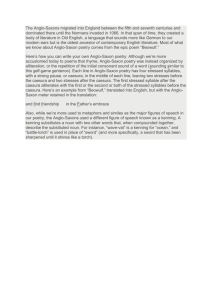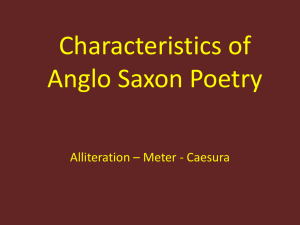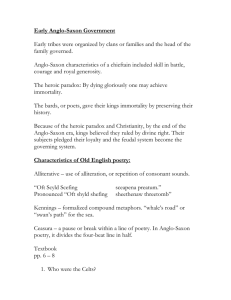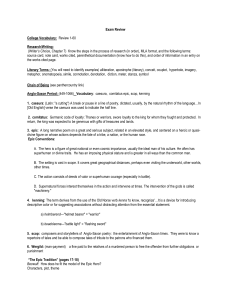DioGuardi/10 Grade In studying, albeit briefly, the Anglo-Saxon period, you have learned...
advertisement
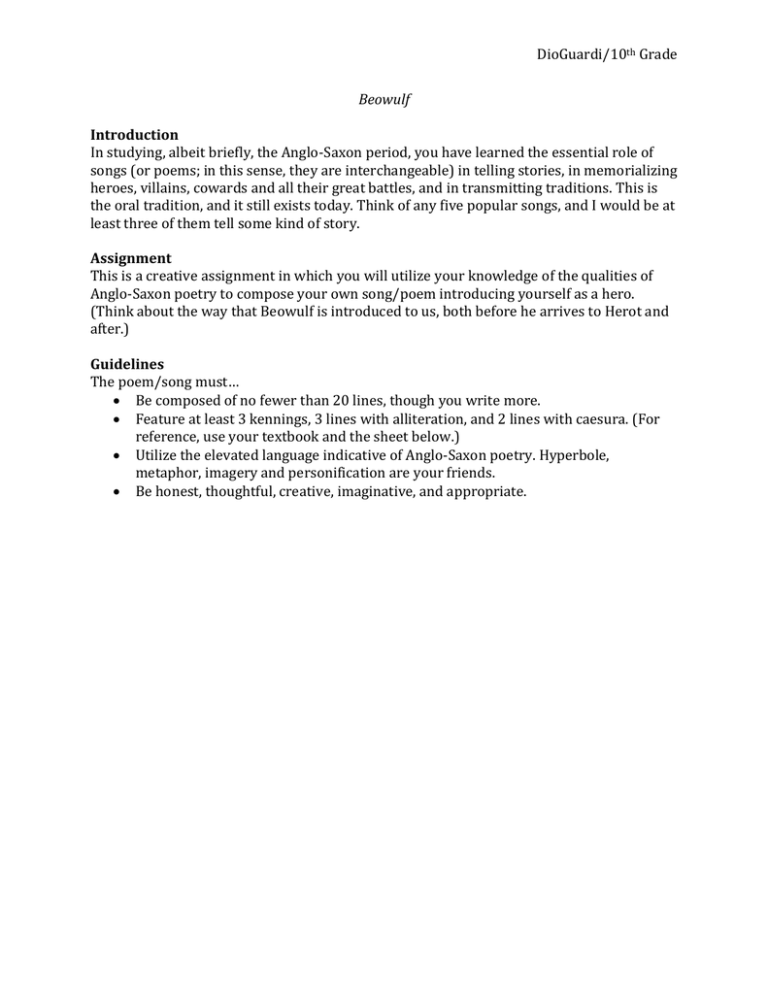
DioGuardi/10th Grade Beowulf Introduction In studying, albeit briefly, the Anglo-Saxon period, you have learned the essential role of songs (or poems; in this sense, they are interchangeable) in telling stories, in memorializing heroes, villains, cowards and all their great battles, and in transmitting traditions. This is the oral tradition, and it still exists today. Think of any five popular songs, and I would be at least three of them tell some kind of story. Assignment This is a creative assignment in which you will utilize your knowledge of the qualities of Anglo-Saxon poetry to compose your own song/poem introducing yourself as a hero. (Think about the way that Beowulf is introduced to us, both before he arrives to Herot and after.) Guidelines The poem/song must… Be composed of no fewer than 20 lines, though you write more. Feature at least 3 kennings, 3 lines with alliteration, and 2 lines with caesura. (For reference, use your textbook and the sheet below.) Utilize the elevated language indicative of Anglo-Saxon poetry. Hyperbole, metaphor, imagery and personification are your friends. Be honest, thoughtful, creative, imaginative, and appropriate. DioGuardi/10th Grade General Characteristics of Anglo-Saxon Poetry By Maistreas Derbail inghean Chonchobar and Ld. Dyfn ap Meurig Version 2 The Ingredients of Structure 1. Alliteration Anglo-Saxon poetry is alliterative rather than rhyming. Alliteration refers to repeating identical consonants, particularly in stressed syllables. For example: “There Théoden fell, Thengling mighty.” “The elder warrior, unwounded, sinks down.” The underlined portions of text are alliterations. The general rules in Anglo-Saxon poetry are that all vowels alliterate each other, and that alliteration always occurs on a stressed syllable. What alliterates? In general, a consonant sound alliterates with itself. But. . . Consonant clusters are considered separate sounds (s, st-, sp-, and sc- do not alliterate). Vowels alliterate with other vowels (although you should use the same vowel sound whenever possible) – note that we are talking about sounds, so honor alliterates directly with onward, and thus can work with oath or any other vowel sound. 2. Half-lines A “line” of poetry from this period is really two half-lines put together. In the Théoden example above, a comma conveniently separates the half-line, but this isn’t always the case. The intentional pause (sometimes called a syntactical boundary) between half-lines is known as a caesura. In period, the caesura was generally a natural pause (such as the end of a sentence), and it is possible a harp strum or other musical “break” would separate the half-lines when a speaker recited the poem; Anglo-Saxon poetry was an oral tradition more than a written one. In modern transcription, the caesura is usually denoted by two vertical lines or by an exaggerated space: “There Théoden fell, || Thengling mighty.” “The elder warrior, unwounded, sinks down.” DioGuardi/10th Grade 3. Meter and Stress Philologists and literature experts have codified the known types of stress1 and meter in Anglo-Saxon poetry, and these are generally called Sievers’ types, after the professor who described them. In the following shorthand, / shows primary stressed syllable, • shows a secondary stressed syllable, and ′ shows an unstressed syllable. Note that extra unstressed syllables can be inserted without changing the type (the stressed syllables determine the type), but that adding between two and five was the norm. For example, ′′/′/ would still be type B. Type A. B. C. D.a. D.b. E. Stresses /′/′ ′/′/ ′//′ //•′ //′• /′′/ Example (Major stress in bold, minor in italics) Hostig Hardrad On high hills or low (′/′′/) The white snow fell Bright archangels Bold brazen faced (//′•′) High-seated king The preference seen in existent Anglo-Saxon poetry seems to have been to use two different Sievers’ types for each half-line to make one full line.2 Mix Well and Serve Putting it all together, here are the rules for making a proper Anglo-Saxon verse: a. Each line is divided into two half-lines. The caesura should be a natural pause if possible. b. Each half-line must have two major accents only. These may be two major accents alone, or two major and one minor accent. Extra unaccented syllables are fine, but two to five are the suggested minimum and maximum additions. Having just one or two is fine (See Sievers’ type D.a. and D.e.). Sievers’ types A, D, and E are most common.3 c. The third stressed syllable must alliterate with the first or second stressed syllable (either or both)4. Alliteration is a rather tricky business, and different scholars of this style of poetry have varying approaches to what consonants and vowels “genuinely” alliterate. For example, will “th” alliterate only with “th” or will it also alliterate with “t”? Beowulf, for one example, shows quite sophisticated alliteration, such as “Beowulf/bode/burg,” “Leader/beloved/long/ruled,” and “fame/folk/father.” Stress can mean several things, such as emphasis or a “lift” in the voice when the stressed word or syllable is spoken. Likewise, unstressed can mean a softening or a “drop” in the voice. 2 M. Wendy Hennequin suggests it was gauche to do two of the same type of half-lines to make the same full line. See Building Blocks of Old English. Because the structure of the languages and our own tastes have changed over 1000 years, I personally don’t agonize over varying Siever’s types when writing poems. 3 See Pronunciation of Old English, in bibliography. 4 Modern writers sometimes put the key alliteration on the fourth stressed syllable. It’s easier, but not strictly correct for Old English poetry. 1 DioGuardi/10th Grade Free Advice: Don’t force it. A good poem should sound fairly natural. We’ve all heard (and probably wrote, in school) poems spoken in unnatural singsong to conform to the assigned meter, with odd and awkward word choices to get the rhyme scheme correct. You can avoid this. While somewhat unfamiliar to our rhyme-trained ears, its variable rhythm should make it easier to write than most Romantic styles. Read. Practice. As your ear tunes itself to the poetic form, the form will be easier to write. If you are performing for a bardic circle or hall performance, an occasional slip in form is okay if it gives your poem more impact. If the poem is for a competition, though, you should be able to show where the work deviates from the proper form, and explain why you did it. Flavor to Taste Now that you have the basic structure, here is a look at what the poets did with it: 1. Style Three key elements to Anglo-Saxon poetry are kennings, variations, and litotes. A kenning is a poetic compound that is interesting to the reader/listener and also provokes a strong image. In short, a kenning replaces more bland nouns with evocative impressions. For example, rather than using the word “blood,” the kenning “wound-dew” is more suggestive. Kennings also tended to be clever, mysterious, and, according to Chickering (1989), deliberately ambiguous and possessing a sort of double entendre. A variation is a repetition of a noun previously used in the sentence, except with a different set of words, often descriptive, in place of the noun. (Clearly, Anglo-Saxons enjoyed the repetition). For example, “glory, the reputation for valor” would be a variation. Finally, there is litotes, a form of verbal irony. This can take the form of an overstatement, such as in Beowulf when the hero is in the clutch of Grendel’s mother, and the author writes over and over again what deep trouble Beowulf is in. Other times, the irony is more of an understatement. Both approaches heighten the emotion of the poetry. The end result is poetry that is somewhat hyperbole and perhaps even melodramatic in terms of modern tastes. However, I have tried to be true to the form, no matter how unusual the end result may seem to my own ears. 2. Formula Why did Anglo-Saxon poets have all these rules? Several possibilities present themselves. First of all, when spoken, the beat of the poetry and the use of kennings and variations have a pleasing sound, one that is more formal and specialized than everyday speech. The style, perhaps, was intended to set poetry apart from the common tongue. Moreover, when written, the poetry wasn’t broken into lines, as we do in modern times. By adding the pronounced differences, a poet could turn a jumble of words into something more meaningful and profound. DioGuardi/10th Grade Another part of the formula was careful description of persons and their roles in society. Two specific means of describing people appear, using the technique of variation (where the variation provides the description of the person’s proper name): a. Person/name, variation. Example: Wiglaf, the son of Weahston, spoke true words. b. Person/name…variation (the ellipses represent other words not part of variation). Example: The guard spoke when he sat on his horse, a fearless officer. 3. Common Themes and Subjects Anglo-Saxon poetry runs an incredible gamut of topics, from the fantastical monsters in Beowulf, to the religious topics of the Gospels. The following are some of the most common themes or subjects mentioned in Anglo-Saxon poetry; even if not particularly appropriate to the poem’s main story, these words or ideas will often appear in the poetry: Battle, war, warriors; seas; storms; ravens; eagles; wolves; death, dying; fate, destiny; nobles, rulers; weapons and armor.
